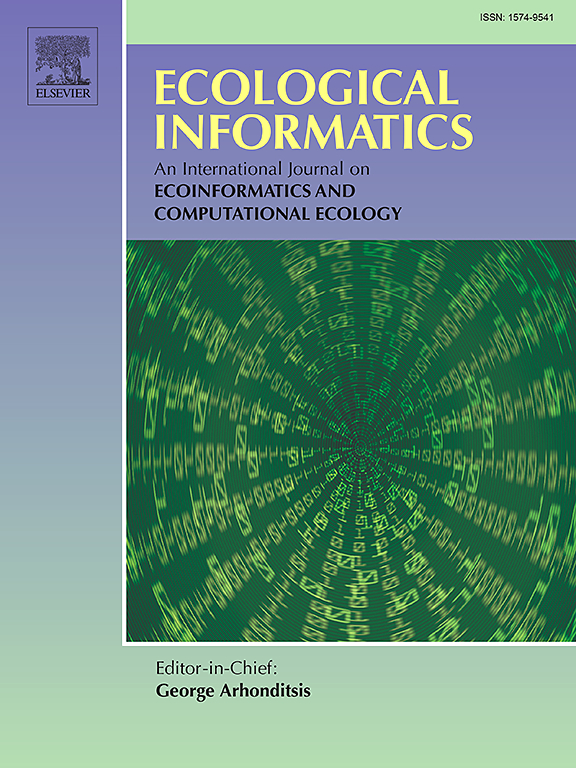Canopy extraction of mango trees in hilly and plain orchards using UAV images: Performance of machine learning vs deep learning
IF 5.8
2区 环境科学与生态学
Q1 ECOLOGY
引用次数: 0
Abstract
Mango is an important fruit widely grown in tropical and subtropical regions. Intelligent and accurate pesticide spraying for mango orchard can significantly improve yield and quality of mango. To obtain the information of mango canopy accurately is the key to realize the precision pesticide spraying of mango orchard. However, it is still a challenge to use the remote sensing technology of unmanned aerial vehicle (UAV) to accurately extract canopy information in orchards with different landforms. The visible light images of mango orchards with different geomorphological characteristics were collected by a UAV, and the canopies were accurately extracted, and their canopy areas were accurately predicted based on deep learning method in this study. Firstly, visible light images collected by a UAV were used to segment and extract mango tree canopies using various machine learning (ML) and deep learning (DL) models. Based on their accuracy, the best-performing models, HR-Net from DL and Extra Trees Classification (ETC) from ML were selected. Subsequently, Mixed Dataset-HR-Net and ETC-CHM (Canopy height model) models were developed based on these optimal models, and their performance was evaluated for canopy segmentation and area extraction in four representative regions. Finally, the influences of different environmental factors, datasets, and Elevation features on the models were discussed. The results indicate that under the influence of factors such as terrain variation, shadows, weeds, and planting density, the Mixed Dataset-HR-Net outperformed the ETC-CHM model. Specifically, the ETC-CHM model was simultaneously affected by shadows, weeds, and planting density, achieving an average segmentation accuracy of 85.56 % and an average rRMSE of 14.53 % for canopy area extraction across the four regions. In contrast, the Mixed Dataset-HR-Net, trained on a diverse dataset, demonstrated strong generalization ability and superior canopy extraction performance. It was solely affected by planting density, achieving an average segmentation accuracy of 94.55 % and an average rRMSE of 8.50 % for canopy area extraction across the four regions. The results provide new perspectives for the accurate extraction of fruit tree canopies in different topographies, which can facilitate precision pesticide spraying in orchards.
利用无人机图像提取丘陵和平原果园的芒果树冠层:机器学习与深度学习的性能对比
芒果是一种重要的水果,广泛生长在热带和亚热带地区。智能精准的芒果园喷洒农药可以显著提高芒果的产量和品质。准确获取芒果树冠信息是实现芒果果园精准农药喷洒的关键。然而,利用无人机遥感技术准确提取不同地形果园的冠层信息仍然是一个挑战。本研究利用无人机采集不同地貌特征的芒果果园可见光图像,基于深度学习方法对其冠层进行准确提取,并对其冠层面积进行准确预测。首先,利用无人机采集的可见光图像,利用各种机器学习(ML)和深度学习(DL)模型对芒果树冠层进行分割和提取。基于它们的准确性,选择了表现最好的模型,DL中的HR-Net和ML中的Extra Trees Classification (ETC)。在此基础上建立了混合数据集- hr - net和ETC-CHM(冠层高度模型)模型,并对4个代表性区域的冠层分割和面积提取进行了性能评价。最后,讨论了不同环境因子、数据集和高程特征对模型的影响。结果表明,在地形变化、阴影、杂草和种植密度等因素的影响下,混合数据集- hr - net模型优于ETC-CHM模型。其中,ETC-CHM模型同时受到阴影、杂草和种植密度的影响,4个区域的冠层面积提取的平均分割精度为85.56%,平均rRMSE为14.53%。相比之下,混合数据集(Mixed dataset - hr - net)具有较强的泛化能力和较好的冠层提取性能。4个区域冠层面积提取的平均分割精度为94.55%,平均rRMSE为8.50%。研究结果为不同地形下果树冠层的准确提取提供了新的思路,为果园精准施药提供了依据。
本文章由计算机程序翻译,如有差异,请以英文原文为准。
求助全文
约1分钟内获得全文
求助全文
来源期刊

Ecological Informatics
环境科学-生态学
CiteScore
8.30
自引率
11.80%
发文量
346
审稿时长
46 days
期刊介绍:
The journal Ecological Informatics is devoted to the publication of high quality, peer-reviewed articles on all aspects of computational ecology, data science and biogeography. The scope of the journal takes into account the data-intensive nature of ecology, the growing capacity of information technology to access, harness and leverage complex data as well as the critical need for informing sustainable management in view of global environmental and climate change.
The nature of the journal is interdisciplinary at the crossover between ecology and informatics. It focuses on novel concepts and techniques for image- and genome-based monitoring and interpretation, sensor- and multimedia-based data acquisition, internet-based data archiving and sharing, data assimilation, modelling and prediction of ecological data.
 求助内容:
求助内容: 应助结果提醒方式:
应助结果提醒方式:


